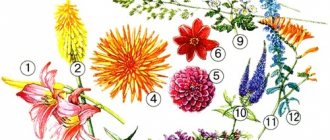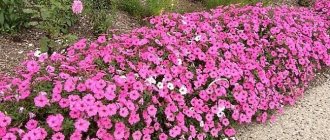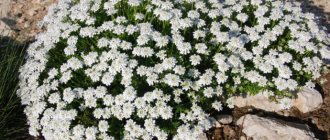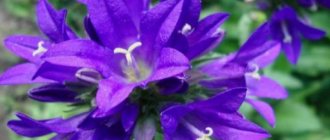Popular border flowers are annual and low-growing
Gardeners often look for low-growing varieties of border flowers that grow within one year. This is convenient from the point of view of the opportunity to change crops annually and fill the garden with new and interesting options. We suggest you focus your attention on the most popular representatives, which are especially loved by gardeners.
Beautiful annual petunia flower
Petunia is the queen of any flower bed. It has a stunning appearance and fills the garden with bright and rich colors. The main thing is to choose a good sunny place for the crop, and do not forget to water it systematically. You can grow a flower either directly into the ground or through seedlings. Refined varietal varieties are best sown through seedlings.
Bright petunia fits perfectly into the role of border plants.
To prolong the flowering of petunia, it is necessary to remove faded buds. This will allow you to enjoy not only rich flowers until autumn, but will also make the shape of the bush extremely compact.
Exquisite marigolds
These border flowers for flower beds reach a height of 0.3 meters. Marigolds (Tagetes) form bushes that produce bright flowers of yellow and orange shades. They thrive in shade and sun. It is allowed to plant marigolds both by seedlings and without seedlings.
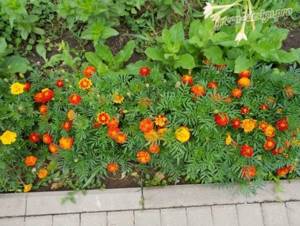
Marigolds are a great option for fall.
During flowering, the bushes look incredibly picturesque; they will delight with their beauty until the first frost. A distinctive advantage of the crops is that they are resistant to various diseases, and thanks to their specific smell, pests do not attack the bushes.
The Incredible Calceolaria
Calceolaria is an ideal low-growing flower for those who want to plant something unusual in their flowerbed. To place the bush, choose semi-shaded areas, this will guarantee abundant flowering of the plant throughout the summer. Watering is carried out extremely carefully to prevent water from getting on the leaves.
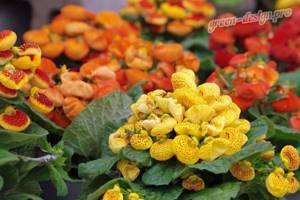
Flowers of incredible beauty and color will decorate any flower bed
It is better to grow these border flowers through seedlings. Calceolaria is placed in garden conditions at the end of May. Monitor the level of watering of the bush; do not allow it to become over-watered, as this will lead to the death of the plant.
Charming salvia
Salvia is a bush with red torch-shaped flowers. They look great in parks and courtyards. The most beautiful are considered to be salvias that have purple, cream-colored petals.

Salvia has long been a favorite of many gardeners
Propagation is usually carried out by seed method through seedlings. After planting in the garden, the crop blooms for 3 months. Looks great in composition with asters and gilly leaves.
Egyptian star pentas
Pentas are often grown as a houseplant, but in summer they can be used to form sophisticated borders by planting them in pots and arranging them in the desired order. Exquisite flowers attract many butterflies to the garden.
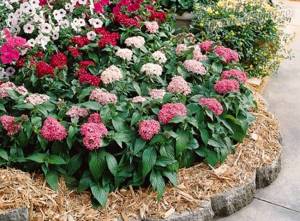
Multi-colored varieties of pentas are perfect as border flowers
The buds are distinguished by white, red, pink shades, as well as purple and lavender. The plant received the unusual name “Egyptian star” due to the visual similarity of the inflorescences to stars.
Cute pansies
Pansies or violets (Viola tricolor) are an opportunity to decorate borders in early spring. These multi-colored border flowers captivate with their variety of shades; they are found in almost all the colors of the rainbow, in several versions on one bud.

The culture feels good with plenty of light; watering is required systematically, but moderately. Among fertilizers, preference is given to mineral compositions.
Catalog of annual border flowers
Many annual flowers that can be used for borders can bloom all summer until frost. Therefore, many of them will frame garden paths or flower beds almost throughout the entire summer season. The only drawback of annuals is that they bloom for only one season, and next year you need to sow them again at home, and then plant them in open ground.
Cineraria maritima

Cineraria seaside (or Silver) blooms only in the second year, but in our area it is grown as an ornamental deciduous annual. Ideal for decorating borders, so it is not surprising that it is widely used for these purposes. Cineraria goes very well with many bright flowers in the flower bed. Open, well-lit areas suit her.
It is optimal to sow Cineraria primaria for seedlings throughout March and early April. The easiest way to sow is in a common bowl. It is necessary to maintain a distance of about 2 centimeters between the seeds, so it is easier to transfer them with a toothpick, but you can simply sow them with your fingers. Sowing must be done superficially, because seeds need light to germinate!
In the photo below you can see Cineraria maritima in a composition with red salvia. This wonderful combination is used very often in borders, because the bright decorative salvia contrasts well with the silvery cineraria.
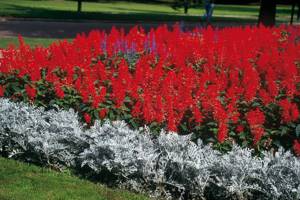
Important! After sowing the seeds of any crop, do not forget to generously moisten the substrate with a spray bottle, and then cover the container with a lid or film to create a greenhouse effect.
Ageratum
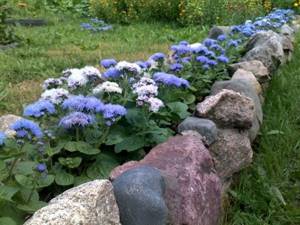
Ageratum (or Longflower) is an ideal annual for the border; not only is it easy to care for, but it blooms all summer until October. Terry blue or purple inflorescences will help to gracefully frame garden paths or flower beds. It reaches its maximum decorative value in sunny, well-lit places with light, neutral, moderately nutritious soil (it is not worth growing on too fertile soil, as it will actively begin to grow green mass to the detriment of flowering).
It is better to start growing ageratum seedlings in the second half of March or early April. The seeds are sown in a wide and low container at a distance of two centimeters from each other, then they are lightly pressed to the ground. Planting is superficial, seeds cannot be covered with soil!
In the photo there are lilac ageratum and marigolds:

Marigold

Marigolds have several names: marigolds, tagetes, Chernobrivtsy. They are almost record holders for use in border compositions (low and medium-growing varieties). Cheerful flowers are used equally often both for edging paths and for framing flower beds. It goes well with many flowers, for example, with cineraria marita, ageratum, zinnia, petunias and many others. Tagetes also acts as an insecticide, that is, it repels pests. With all their advantages, they also bloom all summer until late autumn, and are also very unpretentious. It blooms most beautifully in well-lit places with loose, fertile soil.
Just like in open ground, growing tagetes at home is very simple. Sowing marigold seeds for seedlings is carried out approximately in the second half of March or early April. Holes 1-2 cm deep are made in a common container or separate cups or cassettes, the seed is placed and covered with soil mixed with sand in equal parts. A distance of 3 centimeters must be maintained between seeds.
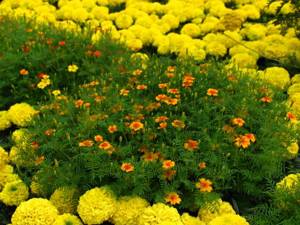
Iberis

Iberis is a pretty, low-growing plant that is well suited for planting along garden paths and beds with low-growing crops and ground cover crops. Iberis can reproduce through self-seeding, so if you want to propagate on your own, immediately after flowering, cut off the faded inflorescences. This unpretentious annual grows best in well-lit areas with loose, light soil. It has a short flowering period (about 1-2 months), but is very lush and fragrant.
Planting Iberis at home occurs in March. Since the crop does not take transplantation very well, it is recommended to immediately sow it in individual cups or cassettes, and then plant it together with a clod of earth. The seeds are sprinkled on top with a 1 millimeter thick layer of sand.
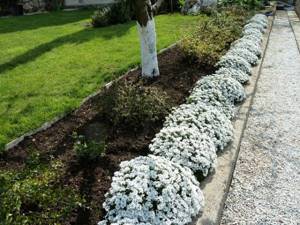
Alyssum

Another name for the beautiful alyssum is marine lobularia. The ground cover flower is unpretentious and undemanding in care. In border plantings it will delight with its appearance and honey aromas throughout the summer. Marine lobularia is ideally suited to a sunny, open location.
Alyssum is usually planted for seedlings at the end of February or in the first half of March. In a wide container, rows should be made 0.3 cm deep and at a distance of 3-4 cm from each other. The seeds are sown evenly in the furrow, and then covered with soil on top (layer thickness 0.2 cm).
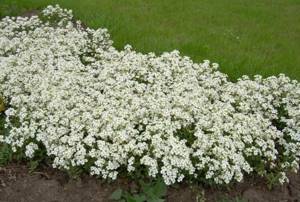
Lobelia erinus
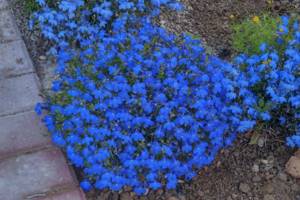
Lobelia erinus (or lobelia border) can act as a very bright accent thanks to its blue flowers. The photo below shows an interesting combination of border lobelia (blue shade) and alyssum (white shade). An annual low-growing crop that blooms all summer, prefers sunny, warm locations with loose, nutritious soil.
Lobelia is sown for seedlings in the last ten days of February and throughout March. A common bowl is used, in which seeds are sown on the substrate (it is more convenient to mix them with sand in advance). There is no need to cover it with soil afterwards.
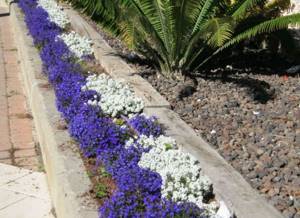
Salvia sparkling

Salvia sparkle is another favorite of many gardeners among a variety of border flowers. Its second name is decorative sage. To frame flower beds or paths, low-growing or medium-growing varieties are often used. Blooms throughout the summer.
Salvia seeds are usually planted for seedlings at the end of March or at the beginning of April. You can plant in almost any container, but it is still more convenient to first plant in a wide bowl and then pick it out. The seeds are mixed with a small amount of sand and scattered evenly, and then lightly pressed to the ground.

Balsam
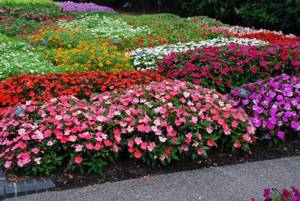
Garden balsam is well suited for creating a border. For decoration, you can use either annuals of the same color or group flowers of different bright shades. It blooms from early to late summer. Prefers areas with moderate, diffused lighting.
It is optimal to sow balsam for seedlings in the second half of March or early April. Depending on what is more convenient for you, you can plant it either in a common bowl (at a distance of 3-5 cm) or in individual cups or cassettes. Sowing of balsam is superficial; it cannot be covered with soil.

Petunia
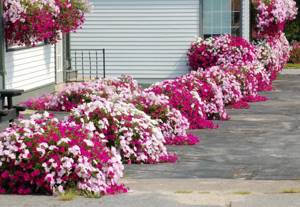
Petunia is widely used to decorate cottages, garden plots, and balconies. One interesting and beautiful way to use it is to plant petunias in border plantings. Thanks to their long flowering period, you can enjoy them all summer long. Also, the abundance of different varieties allows you to create the flowerbed of your dreams.
Petunia can be planted in February or in the first half of March. You can sow in a common bowl or peat tablets. When planting in a common container, seeds should be scattered evenly over the surface. And peat tablets must first be filled with warm water for 30 minutes, and then several seeds must be placed in the center of the tablet.
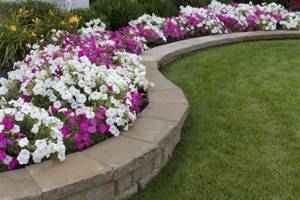
Border low-growing flowering perennial flowers
Border perennial flowers are a great way to create a border for a flowerbed or path once, without having to worry about planting crops every year. There is a huge variety of such plants to harmoniously create interesting landscape solutions. Let's focus on the most original ones.
Bright purslanes
Purslane (Portulaca) is considered an annual, but thanks to its excellent self-seeding, the plant is able to reproduce independently for several years, thereby simplifying the life of the gardener.
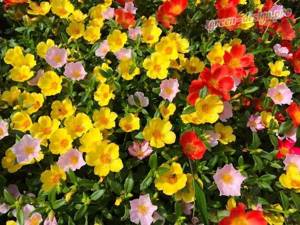
Sun-loving purslanes
Choose well-lit areas, even in direct sunlight. Weeds are not a problem when grown as the crop crowds out other plants around. Minimal watering is required, only during periods of severe drought.
Beautiful border perennial - nemophila
Nemophila is a low-growing border perennial that can reach a height of up to 0.25 meters. The bush is distinguished by its beautiful flowering, openwork leaves with an original pattern along the edges.
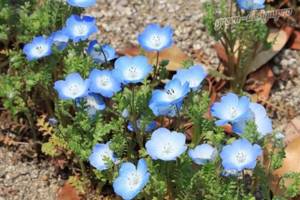
The long flowering period of Nemophila will be an important criterion when choosing border plants
Flowering duration is throughout the summer. It is not afraid of lower temperatures, so it does not need shelter for the winter.
Refined lilies of the valley
May lily of the valley (Convallaria majalis) is a low-growing perennial flower with snow-white bells and wide elliptical leaves. They look great framed by miniature flower beds and ridges.

Plant care is kept to a minimum - it is necessary to regularly water the lily of the valley, especially during periods of drought, and also systematically remove weeds.
Fairytale aubrieta
This is a carpet plant that is ideal for planting in rock gardens. It is used both for decorating flower beds and for self-cultivation. Flowering lasts 1.5 months, starting in May and ending in July.

Few people will remain indifferent to this beautiful ground cover flower - aubrieta
Caring for a shaving is not difficult. The main thing is to water during dry periods using the sprinkling method. After watering, the soil is loosened and weeds are eliminated. Also, do not forget about pruning the bush so that the bush grows new shoots.
Perennial flowers
Once planted, perennial plants will make an amazing setting for a border flower bed.
Arabis is striking in its variety of colors and blooms for almost two months. The only drawback is that the plant grows greatly.
Novice gardeners may confuse feverfew with chamomile. The plant loves the sun very much. Only a painstaking gardener undertakes its cultivation, because pyrethrum requires growing seedlings in a greenhouse, picking and subsequent planting in the ground.
Hosta is beautiful with carved variegated leaves. As it grows, it forms thickets that will have to be removed after flowering. Does not tolerate direct sunlight.
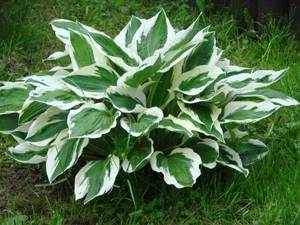
Ranunculus is known as the garden buttercup. You can learn more about planting and growing here.
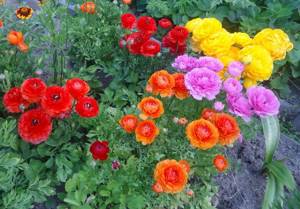
Bright primrose, of various shades, blooms, as a rule, in the second year after it is planted in open ground, but after a year it requires a new transplant. Grows well in the shade, but requires constant watering.
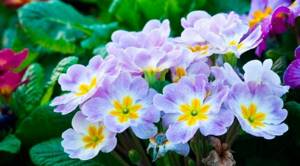
Border aster is valued by flower growers because it blooms when summer flowers have already faded. It grows poorly in the shade and quickly loses its attractiveness if there is a lack of moisture.
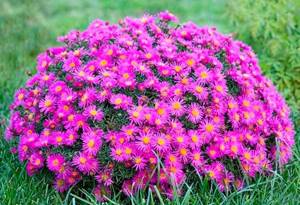
Light, airy irises are extremely popular today. The plant needs sun and a special soil composition, which should include sand, alkaline elements, as well as drainage, which will prevent rotting of the roots.

Blue border flowers
It often happens that gardeners have the specific goal of finding border flowers of a certain shade. This is necessary to form and frame visually attractive flower beds. We offer three of the most interesting representatives of the floristic family, with bluish or blue petals.
Exquisite ageratum
Ageratum can be grown both as a perennial and as an annual (depending on the climatic conditions of the region). It is distinguished by unusually beautiful buds that add brightness to any area. The plant requires systematic watering, as well as the application of fertilizers, then it will give abundant flowering.
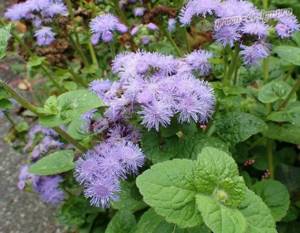
Perennial ageratum in a flowerbed
Ageratum prefers mineral supplements, as well as diluted mullein. For long-term flowering, you will need to systematically remove faded inflorescences.
Bright survivor
Tenacious (Ajuga) is a perennial or annual that can reach a height of up to 0.5 meters. To grow a crop, it must be systematically watered. Until the leaves form on the bushes, do not allow ultraviolet rays to reach the survivor.

The bush develops quickly, so fence off the area where it is planted with pebbles. Remember to remove flowers that have already faded, as this will prolong flowering.
African Lily Agapanthus
Agapanthus prefers sunny areas. It is not demanding on the composition of the soil, but it develops better in nutritious and moist soils. As a maintenance procedure, gardeners recommend systematically fertilizing the plant. For this, mullein or chicken droppings are used.
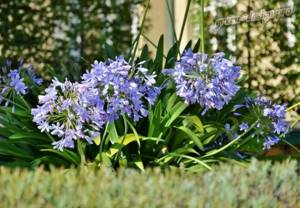
Charming border flower - agapanthus
For the winter season, the African lily will need to be dug up and stored in the basement.
Red border flowers
Unpretentious red garden border flowers are an ideal solution for plain, dim flower beds. We offer several interesting solutions for your own garden.
Incredible gravilate
Gravilat (Geum) is distinguished by rather large flowers that are very attractive to bees. In addition to its decorative properties, the culture is also distinguished by its medicinal characteristics.

The rules for caring for gravel are the systematic removal of weeds and periodic loosening of the soil. Additionally, you will need to remove dry flower stalks, feed and water the bushes.
Exquisite red pyrethrum
Pyrethrum comes in different shades, but red is the brightest and most attractive. The height of the bush is up to 0.7 meters, but there are also low representatives - up to 0.4 meters.
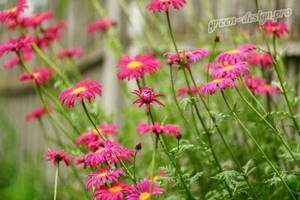
Caring for pyrethrum consists of moderate watering, fertilizing with organic matter and minerals.
Stylish balsams
Impatiens is a low-growing border plant that blooms for a long time. It can bloom in different shades, pink and red being the most popular. The maximum height of the bushes is up to 0.5 meters. Fleshy leaves only add originality to balsam. Impatiens grows in different areas, both with good lighting and in the shade.
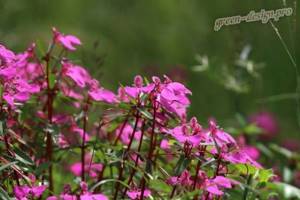
Photo of balsam
The crop needs timely watering; it is moisture-loving. It is fed every 2 weeks, for this purpose mineral compounds are used.
Types of low-growing plants and flowers
The kingdom of annual low-growing flowers is inexhaustible. Flowering carpets in courtyards and flowerpots on balconies in bright or calm colors delight the eye both in the countryside and in the city. Everyone chooses their favorite plants.
Interesting! Some annual flowers have such a rich range of colors that a flowerbed can be decorated from one type of plant. Petunia, begonia, balsam, eschscholzia, and ageratum have a colorful variety.
Marigold
Low, up to 20-30 cm, marigold bushes with yellow and orange flowers grow in the sun and shade, not at all capricious. Their seeds can be sown in warm soil or grown as seedlings. The plants are very lush and picturesque, with long flowering until frost. There are tall varieties, up to 50-60 cm. These are classic low-growing annual border flowers.
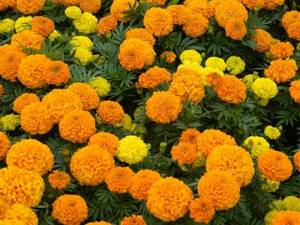
Begonia
Spectacular flower beds of low-growing annuals are decorated with begonia, which is characterized by bright colors. Her partners: alyssum, ageratum, lobelia, pyrethrum. The plant is sown for seedlings in February and planted in May. Flowering continues until autumn. Begonia prefers moderately moist, acidified nutrient soils. The plant does not tolerate drought well.
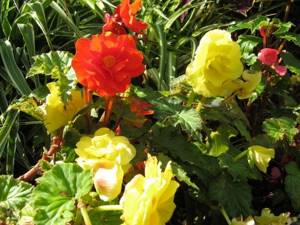
Petunia
Delicate flowers, beloved by many, delight their admirers from spring to autumn. Low-growing annuals bloom luxuriously in a sunny place with sufficient watering. When it rains, the decorative value of flowering plants decreases. Unpretentious acclimatized petunias are propagated by direct sowing into the ground. Exquisite varieties of flowers are grown from seedlings. The seeds are simply laid out on the surface of the soil and lightly pressed. Shoots appear on 10-14 days. To form a good fibrous root, the plants are transplanted into pots twice.
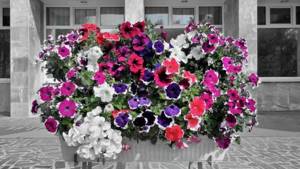
Eschszolzia
Low-growing, from 20 to 40 cm, drought-resistant annuals grow on any soil except acidic. Before sowing, the seeds are kept cold. They are sown in the ground early in the spring, sometimes even in the snow, then mulched, or in the fall. They are small, lightly pressed into the soil and sprinkled with mulch. Eschscholzia can reproduce by self-sowing. The colors of the flowers are varied: white, cream, yellow, orange, red. Creates a very cheerful “sincher” in the garden.
Sophisticated white border flowers
Creating a perennial snow-white border is a stylish solution that will make your area delicate and sophisticated. We present a list of the most beautiful perennials for borders that have white petals.
Campanula White Pouffe
Campanula White Pouffe or bells is a sophisticated, beautiful plant with snow-white petals. Requires systematic watering; the earthen clod is not allowed to dry out. Usually the plant is planted in pots, which are then harmoniously installed in the required places.
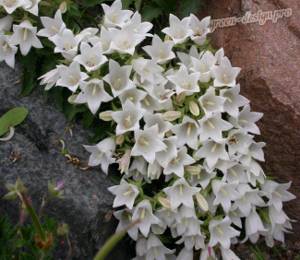
Snow-white bells or campanula
Campanula needs fertilizing, which is carried out once every 14 days. For this, it is preferable to use mineral compositions.
Unpretentious hosta
Hosta is an attractive plant with rich green leaves and bright white flowers. When planted in nutrient soil, the crop does not even have to be fed. But on poor soils, the application of liquid compounds will be required.
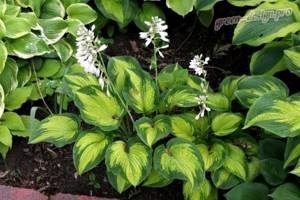
Hosta enchants not only with its white flowers but also with its unique foliage.
It is necessary to water the hosts periodically to ensure that the bush has an attractive appearance. You will also need to loosen the soil, but only at the beginning of cultivation. After 3-4 years, the bushes take root.
Tender Iberis
Iberis is an incredibly beautiful perennial or annual that is distinguished by rich green leaves, as well as sophisticated purple or white flowers. The height of the bush is up to 0.35 meters.

Refined Iberis
It propagates vegetatively, but the seed method is also suitable for such purposes. Iberis prefer lighted places with good, fertile soil. Care consists of fertilizing, which is carried out twice a season, using mineral compounds.
Properly selected border flowers will provide an excellent opportunity to decorate flower beds, paths or other garden compositions with unusual crops.
Annual flowers for border decoration
The border flowerbed will be decorated with sunny lobelia, which amazes with the duration of flowering, which can last until the tops of the flowers are covered with the first frost. But the gardener will have to work hard on the plant: it is better to grow lobelia as seedlings, after planting in open ground, regularly water and feed it, and in late autumn remove the fused dried shoots.
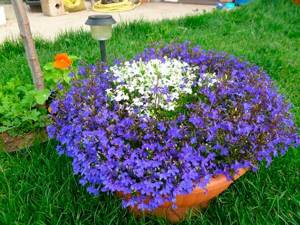
The flowerbed will quickly be covered with snow-white Iberis flowers. The plant is planted as seeds with the onset of the first warm days or in the autumn before frost, but not as seedlings: Iberis does not tolerate transplantation.
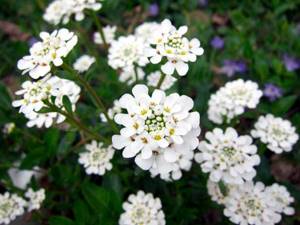
The blue, purple or pink color of ageratum will please the eye - a capricious flower that does not like excessive watering and heavily fertilized soil. But the plant blooms all summer long.
Cineraria with its shade and shape of leaves will add sophistication to the border. You just need to remember that it instantly reacts to increased humidity by changing its color.


